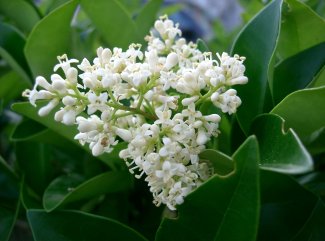northern China, Korea, Japan
An evergreen shrub or small tree growing to 2–5 m (rarely 6 m) tall, with smooth, pale grey-brown bark on the stems. The leaves are opposite, 5–10 cm long and 2–5 cm broad, glossy dark green above, paler glaucous to yellowish green below, thick and leathery textured, and with an entire margin. The flowers are white, with a four-lobed corolla 5–6 mm long; they are born in clusters 7–15 cm long in early summer. The fruit is an oval drupe, 10 mm long, ripening purple-black with a glaucous waxy bloom in early winter; in Japan they are popularly likened to mouse or rat droppings (Wikipedia).
Ligustrum species are common hedges. L. japonicum is listed in the 2007 Sunset Western Garden Book. The fruit is used in herbal medicine as a cardiotonic, diuretic, laxative and tonic treatment. The plant arrived in North America in the early 1800s and has become an invasive plant, particularly in the American South. It is occasionally grown as an ornamental plant in Europe and North America; a number of cultivars have been selected for garden use.
